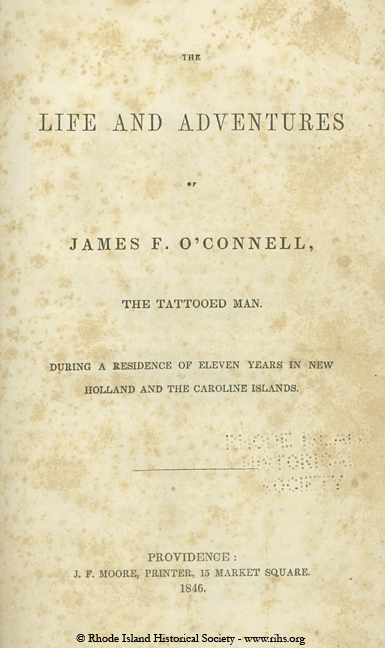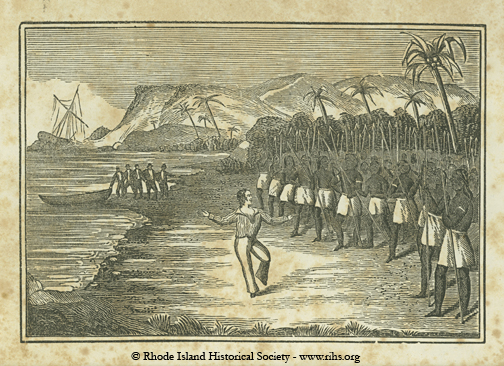 RIHS Collections Assistant Delia Kovac recently came across an item that has everything a Hollywood movie script could ask for: travel, adventure, “natives”, and—of course—dancing:
RIHS Collections Assistant Delia Kovac recently came across an item that has everything a Hollywood movie script could ask for: travel, adventure, “natives”, and—of course—dancing:
The Life and Adventures of James F. O’Connell, The Tattoed Man. During a Residence of Eleven Years in New Holland and the Caroline Islands, Providence: J.F. Moore, 1846. (CT275 .O18 A3)
Here’s an outline of the story with some selected quotes:
- O’Connell realizes his mother is a circus performer
- Sails as a cabin boy on a transport ship for female convicts (“… two hundred ‘ladies’—for so I suppose we are bound to style them…”)
- Joins as a crewman on a whaler and ends up in a storm (“the sea looked…as if it was filled with white cats coming to take our vessel by storm”)
- Shipwreck, four grueling days in a lifeboat, death of companions, suggestions of cannibalism, etc., etc.
- Washes up in the Caroline Islands, eating “the flesh of the kangaroo and bandycoot”
- Plenty of racism (the “savages” are “the connecting link between apes and men…”)
So far, an exciting enough life, but it’s the next phase—with its dancing and tattooing that makes O’Connell’s story so successful:

- In 1826, on board another whaler headed to Japan (“bowling along under easy sail”)
- The ship runs into a coral reef (“Captain Backus was, as usual, drunk on the hencoop”)
- In a lifeboat with a missionary’s wife and daughter and some other sailors. The mother and daughter die on the third day in the lifeboat and are buried at sea. Land sighted the next day.
- O’Connell captured by island residents and brought to the canoe-house, where he is poked and prodded (“My companions feared the Indians were cannibals, and that this examination was to discover whether we were in good roasting case”)
- “In a sort of desperate feeling of recklessness, I determined to try the experiment of dancing upon our savage audience . . . I struck in to Garry Owen, and figured away in that famous jig to the best of my ability and agility.”
- The islanders are pleased. More displays of dancing.
- O’Connell’s dancing is rewarded with a free tattoo from some of the island’s women (” … with a sudden blow from a stick, drove the thorns into my flesh. One needs must when the devil drives; so I summoned all my fortitude, set my teeth, and bore it like a martyr. Between every blow my beauty dipped her thorns in the ink.”)
- O’Connell’s companion doesn’t hold up as well to the tattooing (“He swore and raved without any attention to rule; the way he did it was profane, but not syntaxical or rhetorical”)
- “In the afternoon there came a fresh supply of ladies, who continued tattooing operations on my left arm.”
- Eight full days of tattooing. A month to recover
- “To relieve our weariness, George made a flute of a reed, and fiddle of some light wood; while I, on my part had music in my sole.” (Author’s italics. Surprisingly, he wasn’t killed on the spot for that pun.)
- “The parrots squawled and the dogs howled at a distance, and the scene was romantic enough; but I was more given to dancing than sublime contemplation.”
- Married life: “At night I learned that the young lady who imprinted the last marks upon my arm and breast, was my wife! that last tattooing being part of the marriage ceremony.”
- “My wife was only about fourteen years of age–affectionate, faithful, and fond of baked dogs. During my residence on the island she presented me with two little demi-savages, a girl and a boy…”
- “Happening, however, to awake at midnight, I detected her solacing her grief with a dog’s drum stick…”
- Certain types of cannibalism really are to be expected: “…cannibalism, a practice which is unknown on Bonabee, except, perhaps, so far as tasting an enemy’s heart goes.”
- A variety of failed escape attempts
- O’Connell discovers a “large uninhabited island, upon which were stupendous ruins of a character of architecture differing altogether from the present style of of the islanders.”
- Takes part in a nautical canoe battle between two groups of islanders (prompted by his marriage) that involves deadly slingshots
- Leaves at last on a passing ship and soon gets into a fight with the captain
- Back in Manilla, the captain has O’Connell locked up in jail (“the calabozo”), but he continues to dance
- Apparently, after his return O’Connell and his tattoos were exhibited in circus-fashion.
How much of the story is actually true remains an open question. But in either case, it’s an exciting read.

One thought on “Dancing with the Caroline Islanders”